Short Assignment Title (6-7 ideas in the concept of change management)
VerifiedAdded on 2019/12/03
|11
|3009
|154
Essay
AI Summary
The Soloni Oil was facing challenges in establishing effective communication with their Nigerian team, leading to resistance to change. To overcome this issue, the management should consider providing training for virtual team members on efficient use of technical resources and improving their communication skills. Furthermore, organizational culture can positively or negatively influence virtual teams, depending on whether it is supportive or work-oriented. A positive organizational culture can drive changes in management practices, while a negative one can lead to resistance.
Contribute Materials
Your contribution can guide someone’s learning journey. Share your
documents today.
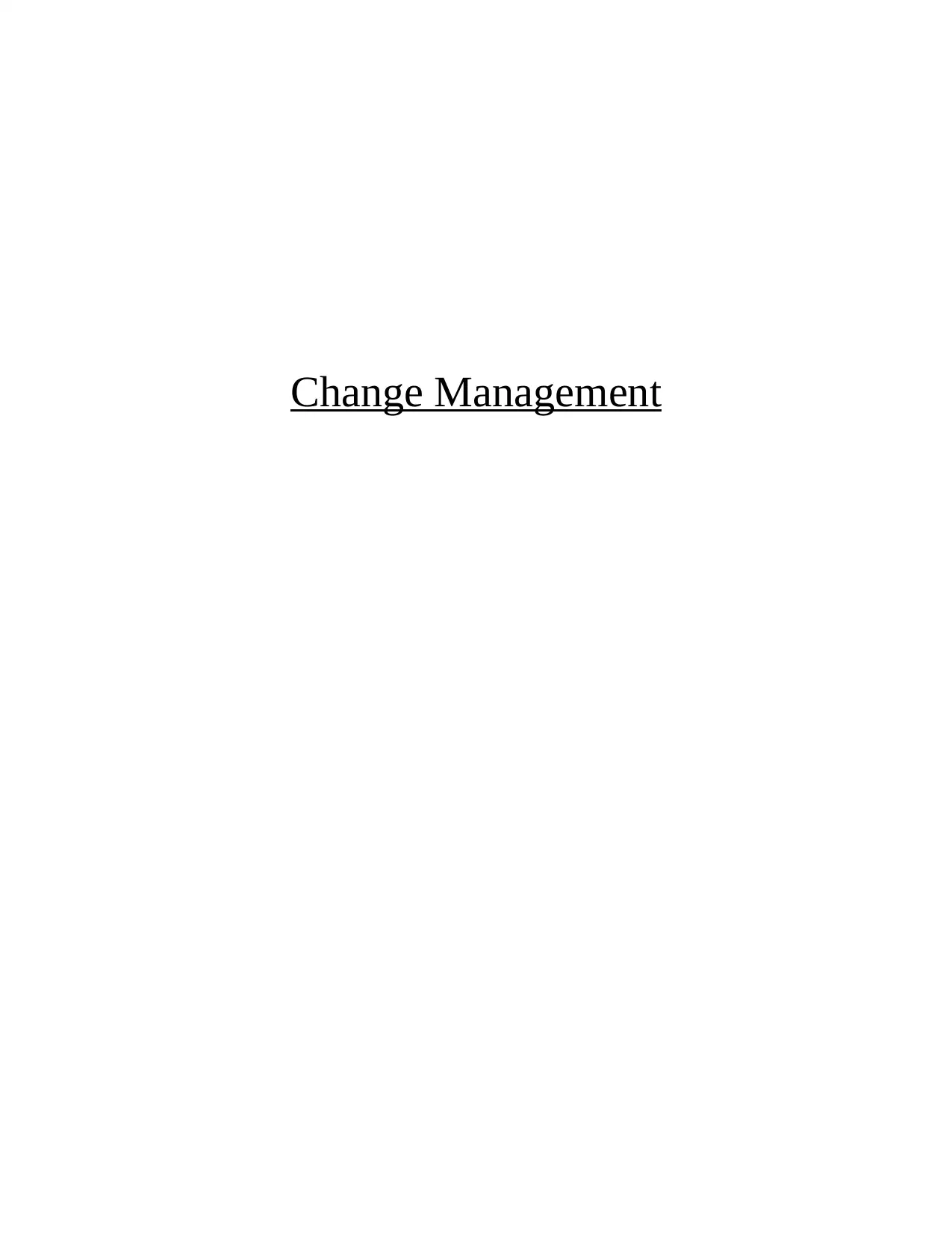
Change Management
Secure Best Marks with AI Grader
Need help grading? Try our AI Grader for instant feedback on your assignments.
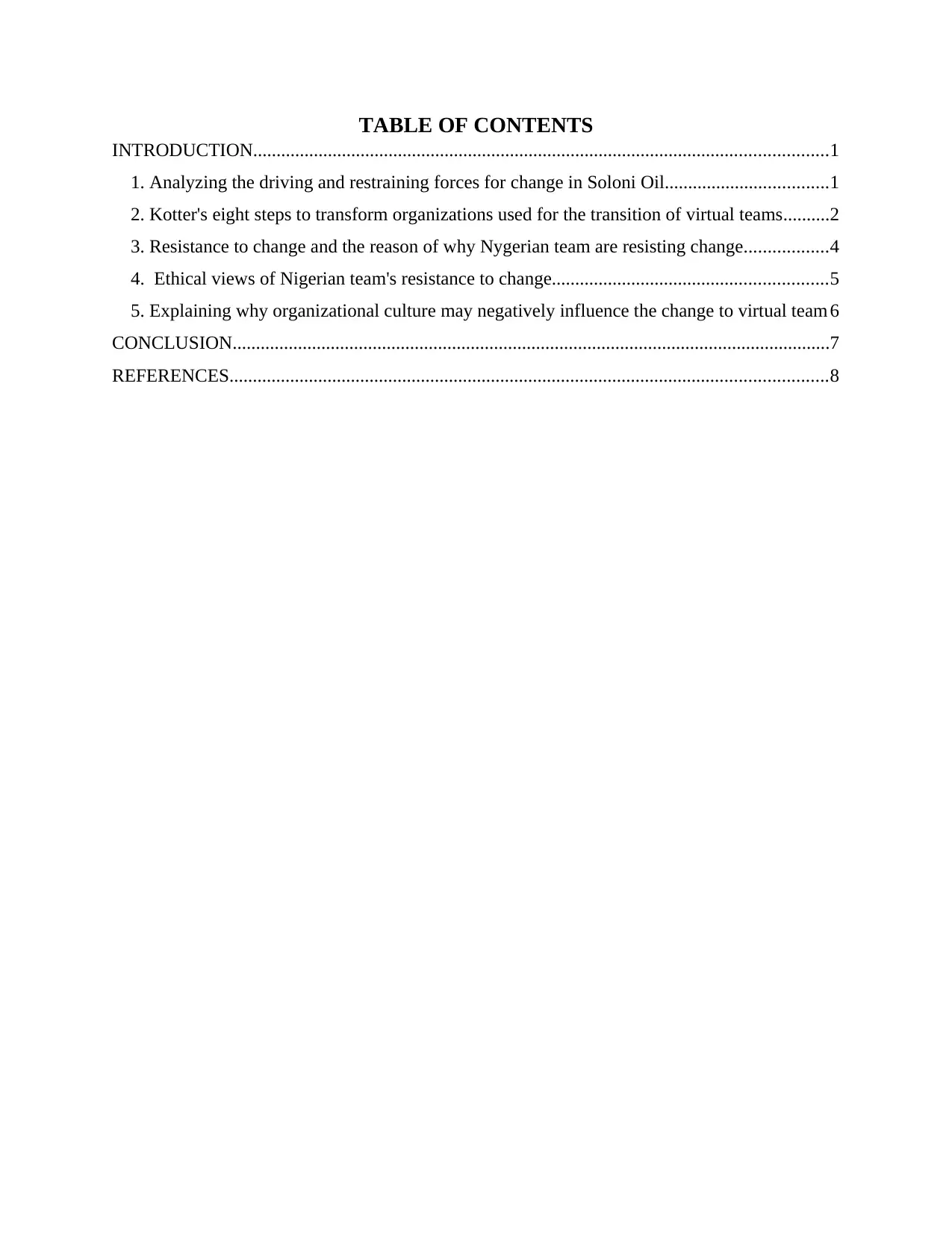
TABLE OF CONTENTS
INTRODUCTION...........................................................................................................................1
1. Analyzing the driving and restraining forces for change in Soloni Oil...................................1
2. Kotter's eight steps to transform organizations used for the transition of virtual teams..........2
3. Resistance to change and the reason of why Nygerian team are resisting change..................4
4. Ethical views of Nigerian team's resistance to change...........................................................5
5. Explaining why organizational culture may negatively influence the change to virtual team 6
CONCLUSION................................................................................................................................7
REFERENCES................................................................................................................................8
INTRODUCTION...........................................................................................................................1
1. Analyzing the driving and restraining forces for change in Soloni Oil...................................1
2. Kotter's eight steps to transform organizations used for the transition of virtual teams..........2
3. Resistance to change and the reason of why Nygerian team are resisting change..................4
4. Ethical views of Nigerian team's resistance to change...........................................................5
5. Explaining why organizational culture may negatively influence the change to virtual team 6
CONCLUSION................................................................................................................................7
REFERENCES................................................................................................................................8
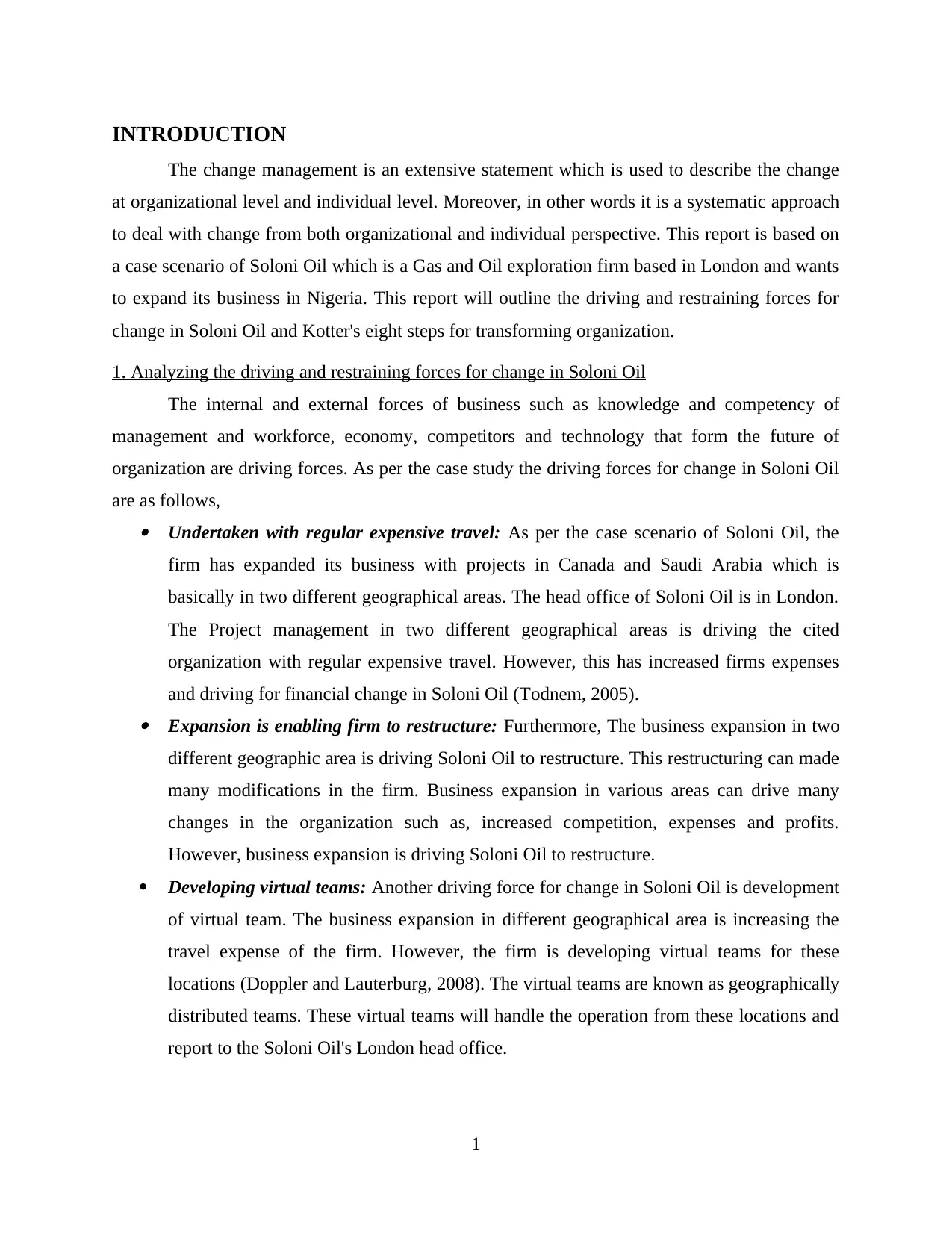
INTRODUCTION
The change management is an extensive statement which is used to describe the change
at organizational level and individual level. Moreover, in other words it is a systematic approach
to deal with change from both organizational and individual perspective. This report is based on
a case scenario of Soloni Oil which is a Gas and Oil exploration firm based in London and wants
to expand its business in Nigeria. This report will outline the driving and restraining forces for
change in Soloni Oil and Kotter's eight steps for transforming organization.
1. Analyzing the driving and restraining forces for change in Soloni Oil
The internal and external forces of business such as knowledge and competency of
management and workforce, economy, competitors and technology that form the future of
organization are driving forces. As per the case study the driving forces for change in Soloni Oil
are as follows, Undertaken with regular expensive travel: As per the case scenario of Soloni Oil, the
firm has expanded its business with projects in Canada and Saudi Arabia which is
basically in two different geographical areas. The head office of Soloni Oil is in London.
The Project management in two different geographical areas is driving the cited
organization with regular expensive travel. However, this has increased firms expenses
and driving for financial change in Soloni Oil (Todnem, 2005). Expansion is enabling firm to restructure: Furthermore, The business expansion in two
different geographic area is driving Soloni Oil to restructure. This restructuring can made
many modifications in the firm. Business expansion in various areas can drive many
changes in the organization such as, increased competition, expenses and profits.
However, business expansion is driving Soloni Oil to restructure.
Developing virtual teams: Another driving force for change in Soloni Oil is development
of virtual team. The business expansion in different geographical area is increasing the
travel expense of the firm. However, the firm is developing virtual teams for these
locations (Doppler and Lauterburg, 2008). The virtual teams are known as geographically
distributed teams. These virtual teams will handle the operation from these locations and
report to the Soloni Oil's London head office.
1
The change management is an extensive statement which is used to describe the change
at organizational level and individual level. Moreover, in other words it is a systematic approach
to deal with change from both organizational and individual perspective. This report is based on
a case scenario of Soloni Oil which is a Gas and Oil exploration firm based in London and wants
to expand its business in Nigeria. This report will outline the driving and restraining forces for
change in Soloni Oil and Kotter's eight steps for transforming organization.
1. Analyzing the driving and restraining forces for change in Soloni Oil
The internal and external forces of business such as knowledge and competency of
management and workforce, economy, competitors and technology that form the future of
organization are driving forces. As per the case study the driving forces for change in Soloni Oil
are as follows, Undertaken with regular expensive travel: As per the case scenario of Soloni Oil, the
firm has expanded its business with projects in Canada and Saudi Arabia which is
basically in two different geographical areas. The head office of Soloni Oil is in London.
The Project management in two different geographical areas is driving the cited
organization with regular expensive travel. However, this has increased firms expenses
and driving for financial change in Soloni Oil (Todnem, 2005). Expansion is enabling firm to restructure: Furthermore, The business expansion in two
different geographic area is driving Soloni Oil to restructure. This restructuring can made
many modifications in the firm. Business expansion in various areas can drive many
changes in the organization such as, increased competition, expenses and profits.
However, business expansion is driving Soloni Oil to restructure.
Developing virtual teams: Another driving force for change in Soloni Oil is development
of virtual team. The business expansion in different geographical area is increasing the
travel expense of the firm. However, the firm is developing virtual teams for these
locations (Doppler and Lauterburg, 2008). The virtual teams are known as geographically
distributed teams. These virtual teams will handle the operation from these locations and
report to the Soloni Oil's London head office.
1
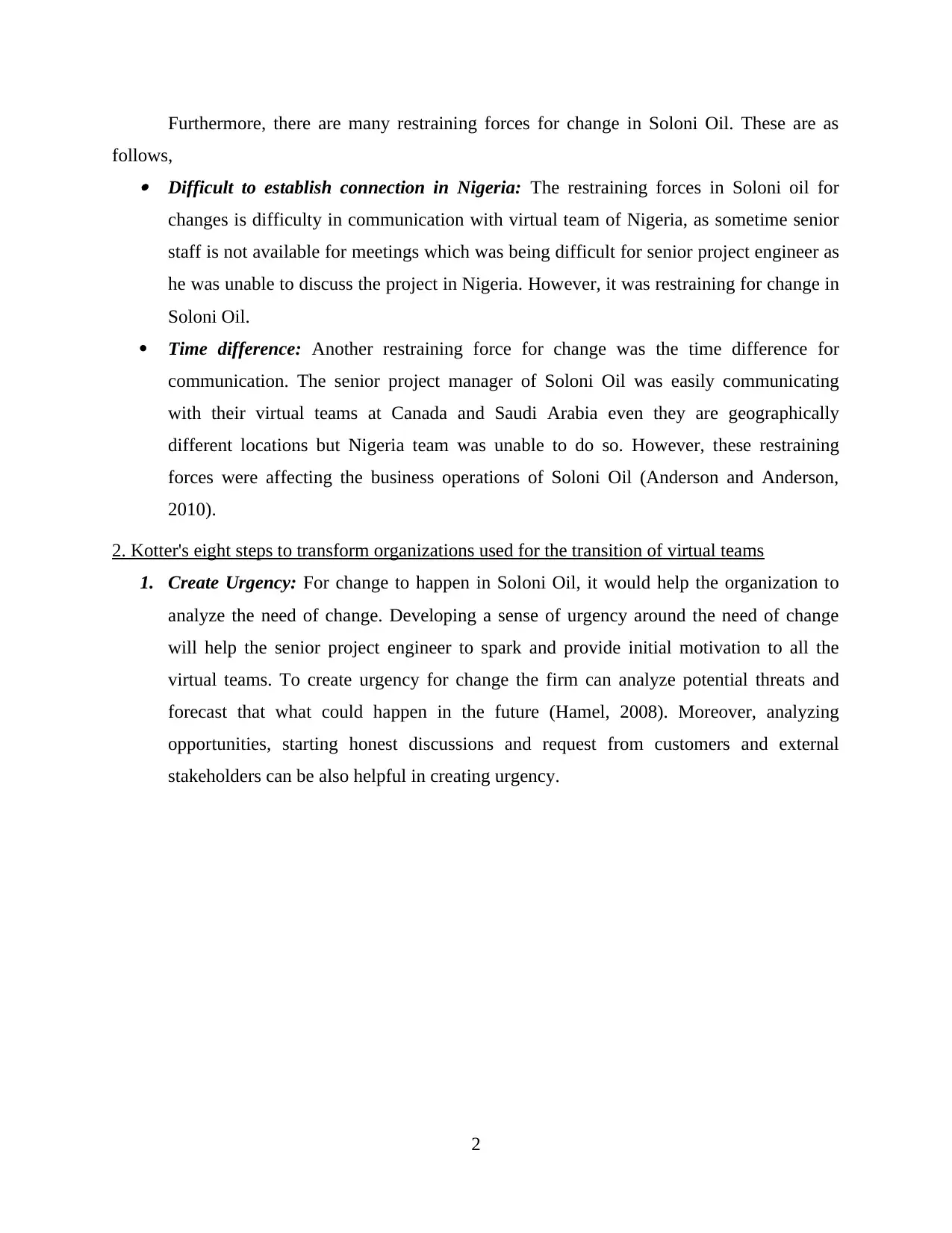
Furthermore, there are many restraining forces for change in Soloni Oil. These are as
follows, Difficult to establish connection in Nigeria: The restraining forces in Soloni oil for
changes is difficulty in communication with virtual team of Nigeria, as sometime senior
staff is not available for meetings which was being difficult for senior project engineer as
he was unable to discuss the project in Nigeria. However, it was restraining for change in
Soloni Oil.
Time difference: Another restraining force for change was the time difference for
communication. The senior project manager of Soloni Oil was easily communicating
with their virtual teams at Canada and Saudi Arabia even they are geographically
different locations but Nigeria team was unable to do so. However, these restraining
forces were affecting the business operations of Soloni Oil (Anderson and Anderson,
2010).
2. Kotter's eight steps to transform organizations used for the transition of virtual teams
1. Create Urgency: For change to happen in Soloni Oil, it would help the organization to
analyze the need of change. Developing a sense of urgency around the need of change
will help the senior project engineer to spark and provide initial motivation to all the
virtual teams. To create urgency for change the firm can analyze potential threats and
forecast that what could happen in the future (Hamel, 2008). Moreover, analyzing
opportunities, starting honest discussions and request from customers and external
stakeholders can be also helpful in creating urgency.
2
follows, Difficult to establish connection in Nigeria: The restraining forces in Soloni oil for
changes is difficulty in communication with virtual team of Nigeria, as sometime senior
staff is not available for meetings which was being difficult for senior project engineer as
he was unable to discuss the project in Nigeria. However, it was restraining for change in
Soloni Oil.
Time difference: Another restraining force for change was the time difference for
communication. The senior project manager of Soloni Oil was easily communicating
with their virtual teams at Canada and Saudi Arabia even they are geographically
different locations but Nigeria team was unable to do so. However, these restraining
forces were affecting the business operations of Soloni Oil (Anderson and Anderson,
2010).
2. Kotter's eight steps to transform organizations used for the transition of virtual teams
1. Create Urgency: For change to happen in Soloni Oil, it would help the organization to
analyze the need of change. Developing a sense of urgency around the need of change
will help the senior project engineer to spark and provide initial motivation to all the
virtual teams. To create urgency for change the firm can analyze potential threats and
forecast that what could happen in the future (Hamel, 2008). Moreover, analyzing
opportunities, starting honest discussions and request from customers and external
stakeholders can be also helpful in creating urgency.
2
Secure Best Marks with AI Grader
Need help grading? Try our AI Grader for instant feedback on your assignments.
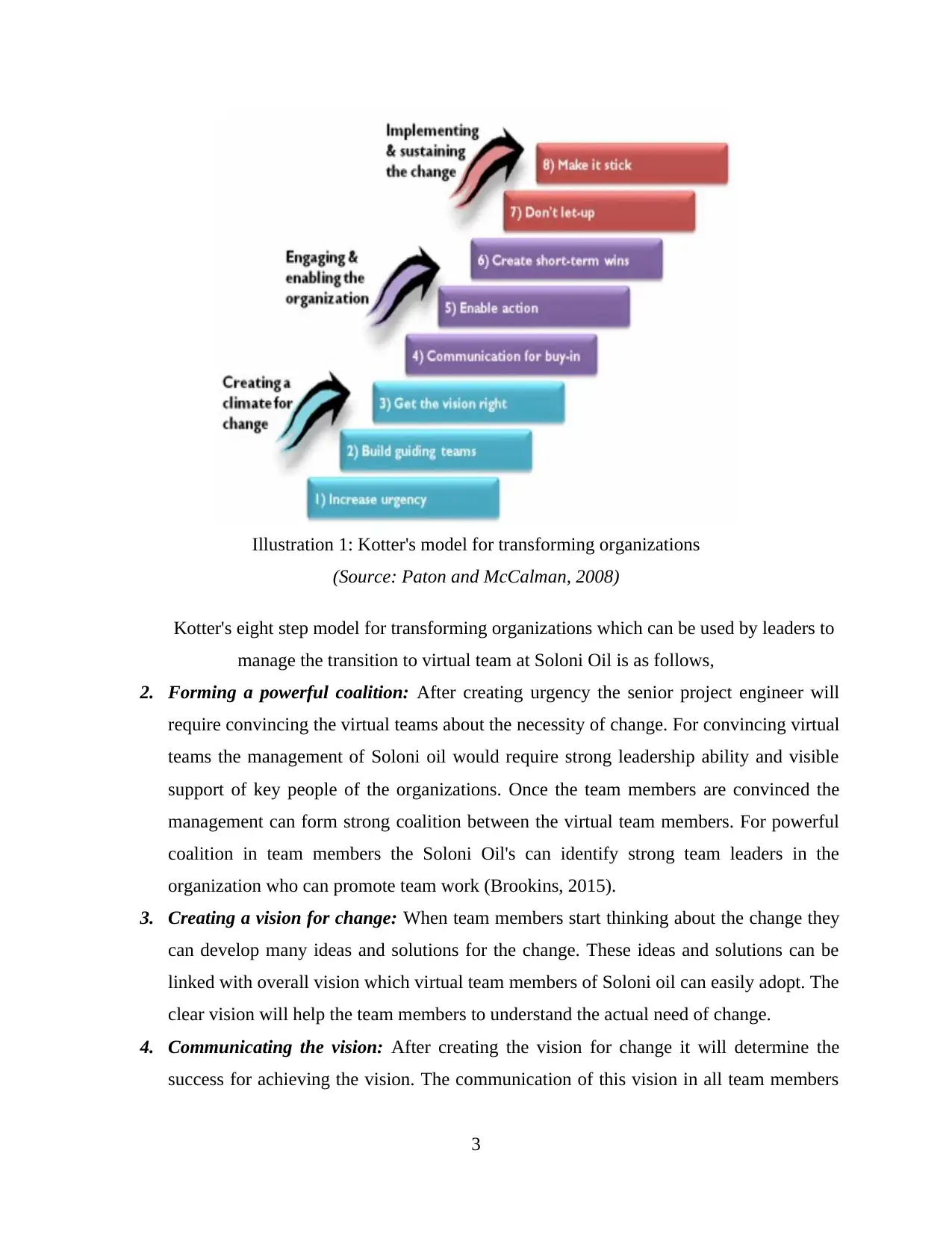
Illustration 1: Kotter's model for transforming organizations
(Source: Paton and McCalman, 2008)
Kotter's eight step model for transforming organizations which can be used by leaders to
manage the transition to virtual team at Soloni Oil is as follows,
2. Forming a powerful coalition: After creating urgency the senior project engineer will
require convincing the virtual teams about the necessity of change. For convincing virtual
teams the management of Soloni oil would require strong leadership ability and visible
support of key people of the organizations. Once the team members are convinced the
management can form strong coalition between the virtual team members. For powerful
coalition in team members the Soloni Oil's can identify strong team leaders in the
organization who can promote team work (Brookins, 2015).
3. Creating a vision for change: When team members start thinking about the change they
can develop many ideas and solutions for the change. These ideas and solutions can be
linked with overall vision which virtual team members of Soloni oil can easily adopt. The
clear vision will help the team members to understand the actual need of change.
4. Communicating the vision: After creating the vision for change it will determine the
success for achieving the vision. The communication of this vision in all team members
3
(Source: Paton and McCalman, 2008)
Kotter's eight step model for transforming organizations which can be used by leaders to
manage the transition to virtual team at Soloni Oil is as follows,
2. Forming a powerful coalition: After creating urgency the senior project engineer will
require convincing the virtual teams about the necessity of change. For convincing virtual
teams the management of Soloni oil would require strong leadership ability and visible
support of key people of the organizations. Once the team members are convinced the
management can form strong coalition between the virtual team members. For powerful
coalition in team members the Soloni Oil's can identify strong team leaders in the
organization who can promote team work (Brookins, 2015).
3. Creating a vision for change: When team members start thinking about the change they
can develop many ideas and solutions for the change. These ideas and solutions can be
linked with overall vision which virtual team members of Soloni oil can easily adopt. The
clear vision will help the team members to understand the actual need of change.
4. Communicating the vision: After creating the vision for change it will determine the
success for achieving the vision. The communication of this vision in all team members
3
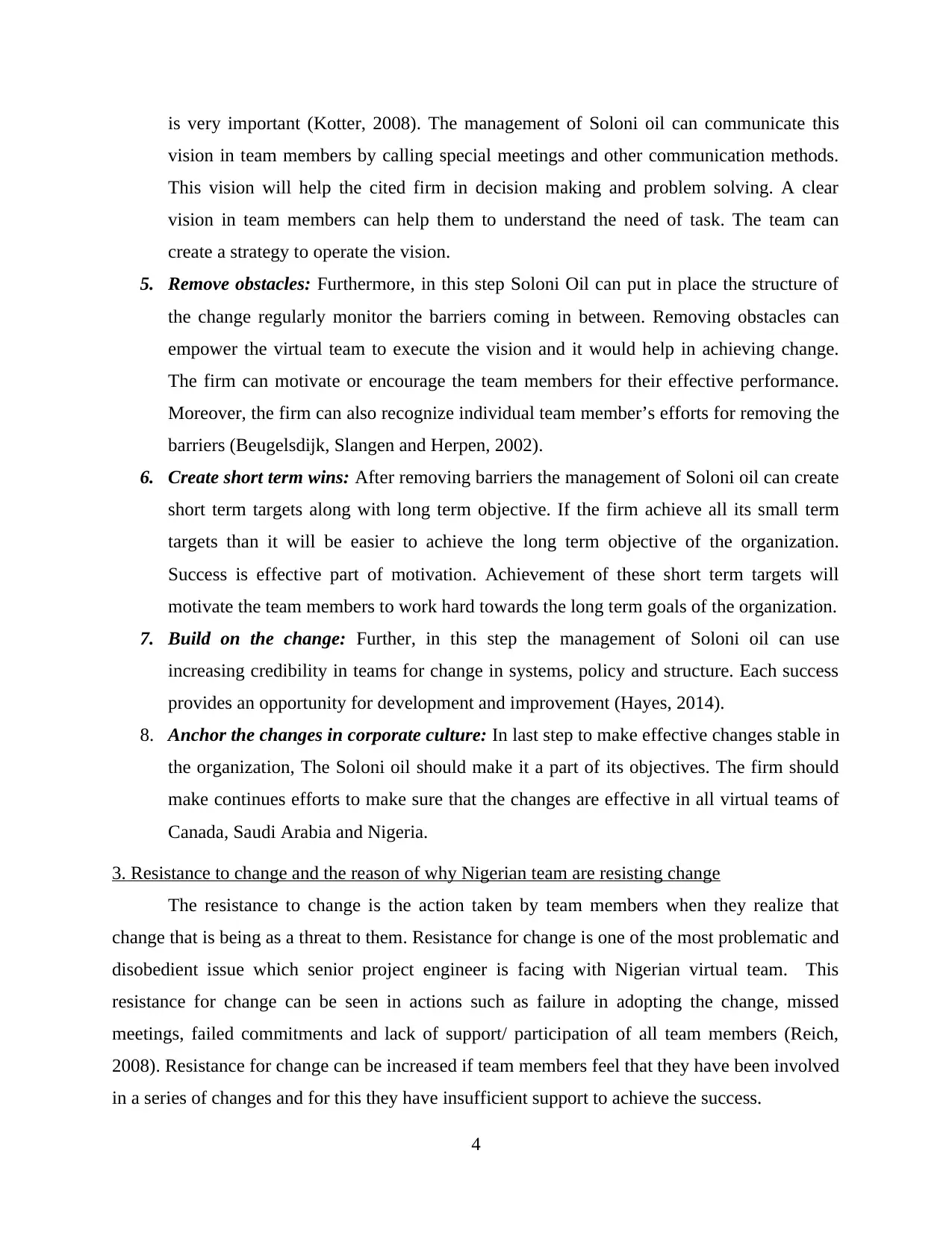
is very important (Kotter, 2008). The management of Soloni oil can communicate this
vision in team members by calling special meetings and other communication methods.
This vision will help the cited firm in decision making and problem solving. A clear
vision in team members can help them to understand the need of task. The team can
create a strategy to operate the vision.
5. Remove obstacles: Furthermore, in this step Soloni Oil can put in place the structure of
the change regularly monitor the barriers coming in between. Removing obstacles can
empower the virtual team to execute the vision and it would help in achieving change.
The firm can motivate or encourage the team members for their effective performance.
Moreover, the firm can also recognize individual team member’s efforts for removing the
barriers (Beugelsdijk, Slangen and Herpen, 2002).
6. Create short term wins: After removing barriers the management of Soloni oil can create
short term targets along with long term objective. If the firm achieve all its small term
targets than it will be easier to achieve the long term objective of the organization.
Success is effective part of motivation. Achievement of these short term targets will
motivate the team members to work hard towards the long term goals of the organization.
7. Build on the change: Further, in this step the management of Soloni oil can use
increasing credibility in teams for change in systems, policy and structure. Each success
provides an opportunity for development and improvement (Hayes, 2014).
8. Anchor the changes in corporate culture: In last step to make effective changes stable in
the organization, The Soloni oil should make it a part of its objectives. The firm should
make continues efforts to make sure that the changes are effective in all virtual teams of
Canada, Saudi Arabia and Nigeria.
3. Resistance to change and the reason of why Nigerian team are resisting change
The resistance to change is the action taken by team members when they realize that
change that is being as a threat to them. Resistance for change is one of the most problematic and
disobedient issue which senior project engineer is facing with Nigerian virtual team. This
resistance for change can be seen in actions such as failure in adopting the change, missed
meetings, failed commitments and lack of support/ participation of all team members (Reich,
2008). Resistance for change can be increased if team members feel that they have been involved
in a series of changes and for this they have insufficient support to achieve the success.
4
vision in team members by calling special meetings and other communication methods.
This vision will help the cited firm in decision making and problem solving. A clear
vision in team members can help them to understand the need of task. The team can
create a strategy to operate the vision.
5. Remove obstacles: Furthermore, in this step Soloni Oil can put in place the structure of
the change regularly monitor the barriers coming in between. Removing obstacles can
empower the virtual team to execute the vision and it would help in achieving change.
The firm can motivate or encourage the team members for their effective performance.
Moreover, the firm can also recognize individual team member’s efforts for removing the
barriers (Beugelsdijk, Slangen and Herpen, 2002).
6. Create short term wins: After removing barriers the management of Soloni oil can create
short term targets along with long term objective. If the firm achieve all its small term
targets than it will be easier to achieve the long term objective of the organization.
Success is effective part of motivation. Achievement of these short term targets will
motivate the team members to work hard towards the long term goals of the organization.
7. Build on the change: Further, in this step the management of Soloni oil can use
increasing credibility in teams for change in systems, policy and structure. Each success
provides an opportunity for development and improvement (Hayes, 2014).
8. Anchor the changes in corporate culture: In last step to make effective changes stable in
the organization, The Soloni oil should make it a part of its objectives. The firm should
make continues efforts to make sure that the changes are effective in all virtual teams of
Canada, Saudi Arabia and Nigeria.
3. Resistance to change and the reason of why Nigerian team are resisting change
The resistance to change is the action taken by team members when they realize that
change that is being as a threat to them. Resistance for change is one of the most problematic and
disobedient issue which senior project engineer is facing with Nigerian virtual team. This
resistance for change can be seen in actions such as failure in adopting the change, missed
meetings, failed commitments and lack of support/ participation of all team members (Reich,
2008). Resistance for change can be increased if team members feel that they have been involved
in a series of changes and for this they have insufficient support to achieve the success.
4
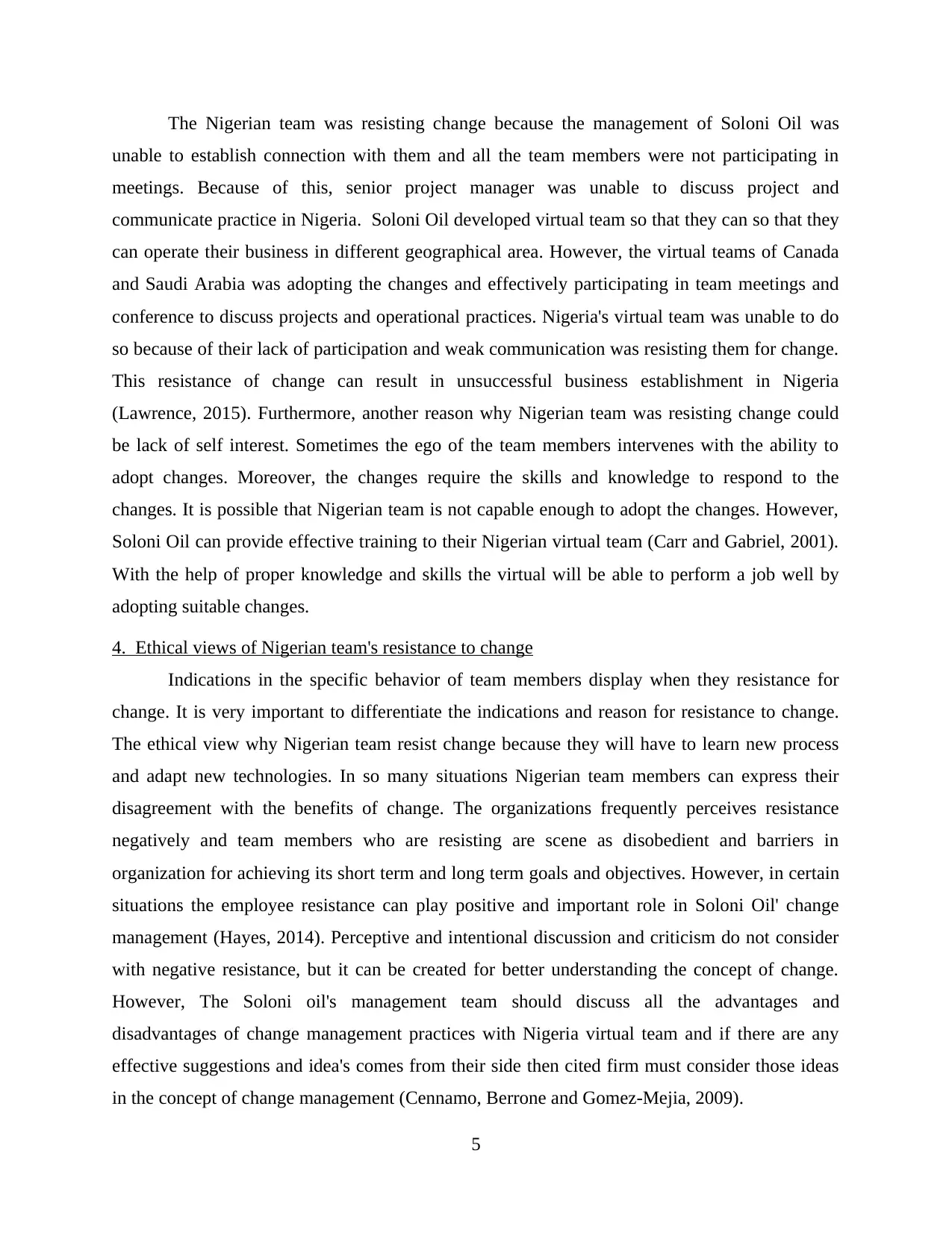
The Nigerian team was resisting change because the management of Soloni Oil was
unable to establish connection with them and all the team members were not participating in
meetings. Because of this, senior project manager was unable to discuss project and
communicate practice in Nigeria. Soloni Oil developed virtual team so that they can so that they
can operate their business in different geographical area. However, the virtual teams of Canada
and Saudi Arabia was adopting the changes and effectively participating in team meetings and
conference to discuss projects and operational practices. Nigeria's virtual team was unable to do
so because of their lack of participation and weak communication was resisting them for change.
This resistance of change can result in unsuccessful business establishment in Nigeria
(Lawrence, 2015). Furthermore, another reason why Nigerian team was resisting change could
be lack of self interest. Sometimes the ego of the team members intervenes with the ability to
adopt changes. Moreover, the changes require the skills and knowledge to respond to the
changes. It is possible that Nigerian team is not capable enough to adopt the changes. However,
Soloni Oil can provide effective training to their Nigerian virtual team (Carr and Gabriel, 2001).
With the help of proper knowledge and skills the virtual will be able to perform a job well by
adopting suitable changes.
4. Ethical views of Nigerian team's resistance to change
Indications in the specific behavior of team members display when they resistance for
change. It is very important to differentiate the indications and reason for resistance to change.
The ethical view why Nigerian team resist change because they will have to learn new process
and adapt new technologies. In so many situations Nigerian team members can express their
disagreement with the benefits of change. The organizations frequently perceives resistance
negatively and team members who are resisting are scene as disobedient and barriers in
organization for achieving its short term and long term goals and objectives. However, in certain
situations the employee resistance can play positive and important role in Soloni Oil' change
management (Hayes, 2014). Perceptive and intentional discussion and criticism do not consider
with negative resistance, but it can be created for better understanding the concept of change.
However, The Soloni oil's management team should discuss all the advantages and
disadvantages of change management practices with Nigeria virtual team and if there are any
effective suggestions and idea's comes from their side then cited firm must consider those ideas
in the concept of change management (Cennamo, Berrone and Gomez-Mejia, 2009).
5
unable to establish connection with them and all the team members were not participating in
meetings. Because of this, senior project manager was unable to discuss project and
communicate practice in Nigeria. Soloni Oil developed virtual team so that they can so that they
can operate their business in different geographical area. However, the virtual teams of Canada
and Saudi Arabia was adopting the changes and effectively participating in team meetings and
conference to discuss projects and operational practices. Nigeria's virtual team was unable to do
so because of their lack of participation and weak communication was resisting them for change.
This resistance of change can result in unsuccessful business establishment in Nigeria
(Lawrence, 2015). Furthermore, another reason why Nigerian team was resisting change could
be lack of self interest. Sometimes the ego of the team members intervenes with the ability to
adopt changes. Moreover, the changes require the skills and knowledge to respond to the
changes. It is possible that Nigerian team is not capable enough to adopt the changes. However,
Soloni Oil can provide effective training to their Nigerian virtual team (Carr and Gabriel, 2001).
With the help of proper knowledge and skills the virtual will be able to perform a job well by
adopting suitable changes.
4. Ethical views of Nigerian team's resistance to change
Indications in the specific behavior of team members display when they resistance for
change. It is very important to differentiate the indications and reason for resistance to change.
The ethical view why Nigerian team resist change because they will have to learn new process
and adapt new technologies. In so many situations Nigerian team members can express their
disagreement with the benefits of change. The organizations frequently perceives resistance
negatively and team members who are resisting are scene as disobedient and barriers in
organization for achieving its short term and long term goals and objectives. However, in certain
situations the employee resistance can play positive and important role in Soloni Oil' change
management (Hayes, 2014). Perceptive and intentional discussion and criticism do not consider
with negative resistance, but it can be created for better understanding the concept of change.
However, The Soloni oil's management team should discuss all the advantages and
disadvantages of change management practices with Nigeria virtual team and if there are any
effective suggestions and idea's comes from their side then cited firm must consider those ideas
in the concept of change management (Cennamo, Berrone and Gomez-Mejia, 2009).
5
Paraphrase This Document
Need a fresh take? Get an instant paraphrase of this document with our AI Paraphraser

Furthermore, the Soloni Oil was unable to establish effective communication with
Nigeria team which was affecting the business practices. However, the management of Soloni
Oil should include some other methods also to communicate with Nigeria team. Nigerian team's
resistance for change can viewed in ethical way as it is possible that Nigerian team has lack of
resources to communicate properly in their UK office. There may be many barriers such as
language issue, lack of knowledge and availability of resources to connect with senior technical
engineer (Turner, 2014). However, The Soloni Oil's need to provide training to their virtual team
for efficient use of technical resources and for improving their communication skills. By
adopting these strategies the firm can over the issue of resistance to change.
5. Explaining why organizational culture may negatively influence the change to virtual team
Every organization has its unique identity, this unique identity is identified as
organizational culture. Organizational culture is process of shared values and beliefs which is
governed by the workforce of organization. These shared values and beliefs have strong
influence on people in organization. However, virtual teams are defined as geographically
distributed team that works for an organization with same goals and objectives. The
organizational culture may have positive and negative influence on virtual teams due to its
transparency. This can also be driving force for change or resistance for change. The
effectiveness and nature to adopt the changes in organizations are highly influenced by its
culture. The changes in management are influenced by the efforts of the virtual teams (Dunphy,
Griffiths and Benn, 2007). The organizations implement the strategies for all teams to achieve
the goals and objectives of the firm. Virtual teams work from outside the organizations on
geographic location. Thereby, the firm needs to establish effective communication with them for
change management. The organization culture should be supportive. It should support team
members' view and suggestion and also organizations should discuss its goals and objectives
with team members.
Further, if organizational culture is only work oriented and not employee oriented then it
could make negative influence for the change to the virtual team. Thus, the organizations should
establish effective communication with them and make them realize that change in management
practices beneficial for them and create positive work culture around them (Kotter, 2008). This
Strategy will make virtual team members to adopt the changes efficiently. On the contrary, if the
organizations culture is only work oriented and there is heavy pressure to perform the job even if
6
Nigeria team which was affecting the business practices. However, the management of Soloni
Oil should include some other methods also to communicate with Nigeria team. Nigerian team's
resistance for change can viewed in ethical way as it is possible that Nigerian team has lack of
resources to communicate properly in their UK office. There may be many barriers such as
language issue, lack of knowledge and availability of resources to connect with senior technical
engineer (Turner, 2014). However, The Soloni Oil's need to provide training to their virtual team
for efficient use of technical resources and for improving their communication skills. By
adopting these strategies the firm can over the issue of resistance to change.
5. Explaining why organizational culture may negatively influence the change to virtual team
Every organization has its unique identity, this unique identity is identified as
organizational culture. Organizational culture is process of shared values and beliefs which is
governed by the workforce of organization. These shared values and beliefs have strong
influence on people in organization. However, virtual teams are defined as geographically
distributed team that works for an organization with same goals and objectives. The
organizational culture may have positive and negative influence on virtual teams due to its
transparency. This can also be driving force for change or resistance for change. The
effectiveness and nature to adopt the changes in organizations are highly influenced by its
culture. The changes in management are influenced by the efforts of the virtual teams (Dunphy,
Griffiths and Benn, 2007). The organizations implement the strategies for all teams to achieve
the goals and objectives of the firm. Virtual teams work from outside the organizations on
geographic location. Thereby, the firm needs to establish effective communication with them for
change management. The organization culture should be supportive. It should support team
members' view and suggestion and also organizations should discuss its goals and objectives
with team members.
Further, if organizational culture is only work oriented and not employee oriented then it
could make negative influence for the change to the virtual team. Thus, the organizations should
establish effective communication with them and make them realize that change in management
practices beneficial for them and create positive work culture around them (Kotter, 2008). This
Strategy will make virtual team members to adopt the changes efficiently. On the contrary, if the
organizations culture is only work oriented and there is heavy pressure to perform the job even if
6
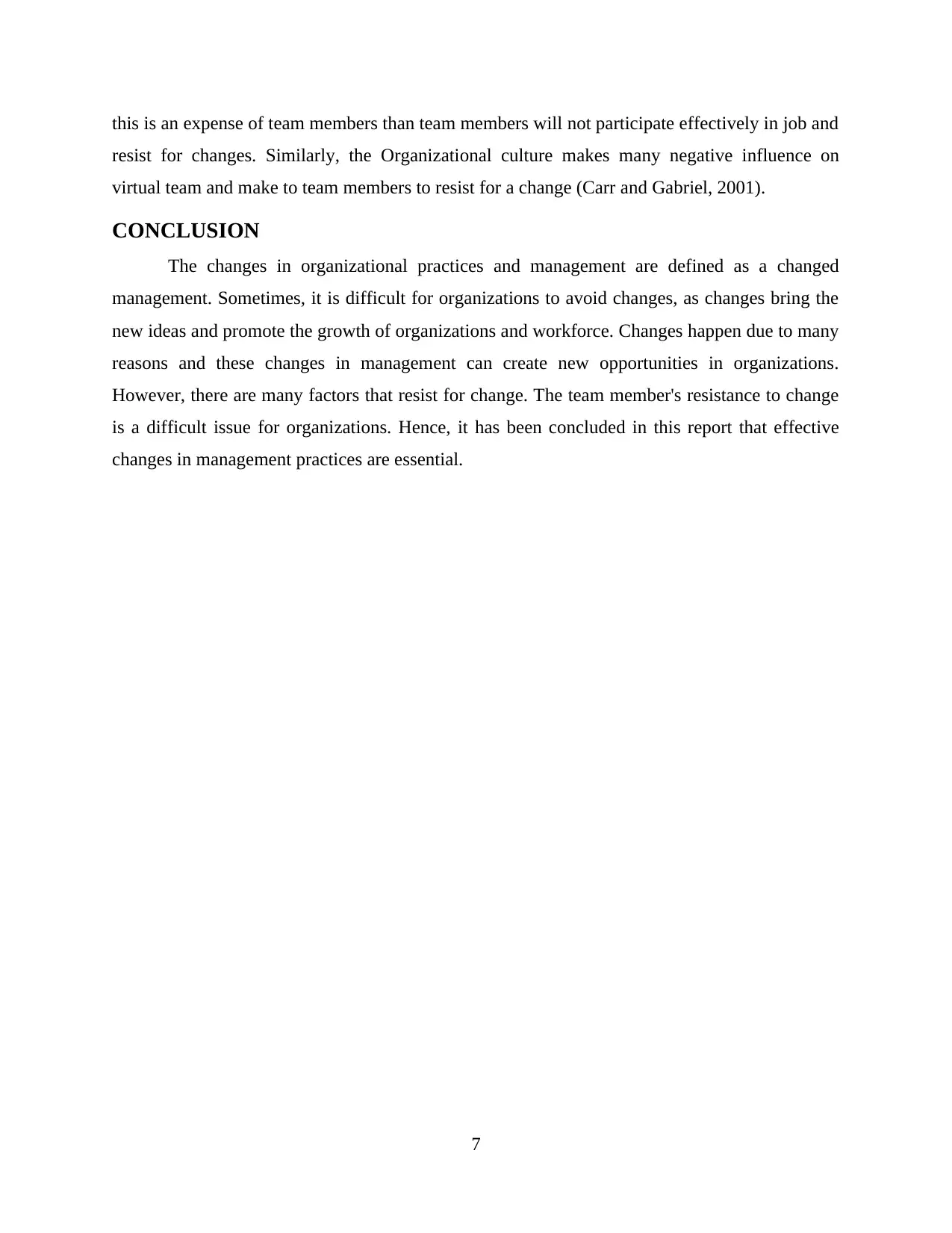
this is an expense of team members than team members will not participate effectively in job and
resist for changes. Similarly, the Organizational culture makes many negative influence on
virtual team and make to team members to resist for a change (Carr and Gabriel, 2001).
CONCLUSION
The changes in organizational practices and management are defined as a changed
management. Sometimes, it is difficult for organizations to avoid changes, as changes bring the
new ideas and promote the growth of organizations and workforce. Changes happen due to many
reasons and these changes in management can create new opportunities in organizations.
However, there are many factors that resist for change. The team member's resistance to change
is a difficult issue for organizations. Hence, it has been concluded in this report that effective
changes in management practices are essential.
7
resist for changes. Similarly, the Organizational culture makes many negative influence on
virtual team and make to team members to resist for a change (Carr and Gabriel, 2001).
CONCLUSION
The changes in organizational practices and management are defined as a changed
management. Sometimes, it is difficult for organizations to avoid changes, as changes bring the
new ideas and promote the growth of organizations and workforce. Changes happen due to many
reasons and these changes in management can create new opportunities in organizations.
However, there are many factors that resist for change. The team member's resistance to change
is a difficult issue for organizations. Hence, it has been concluded in this report that effective
changes in management practices are essential.
7
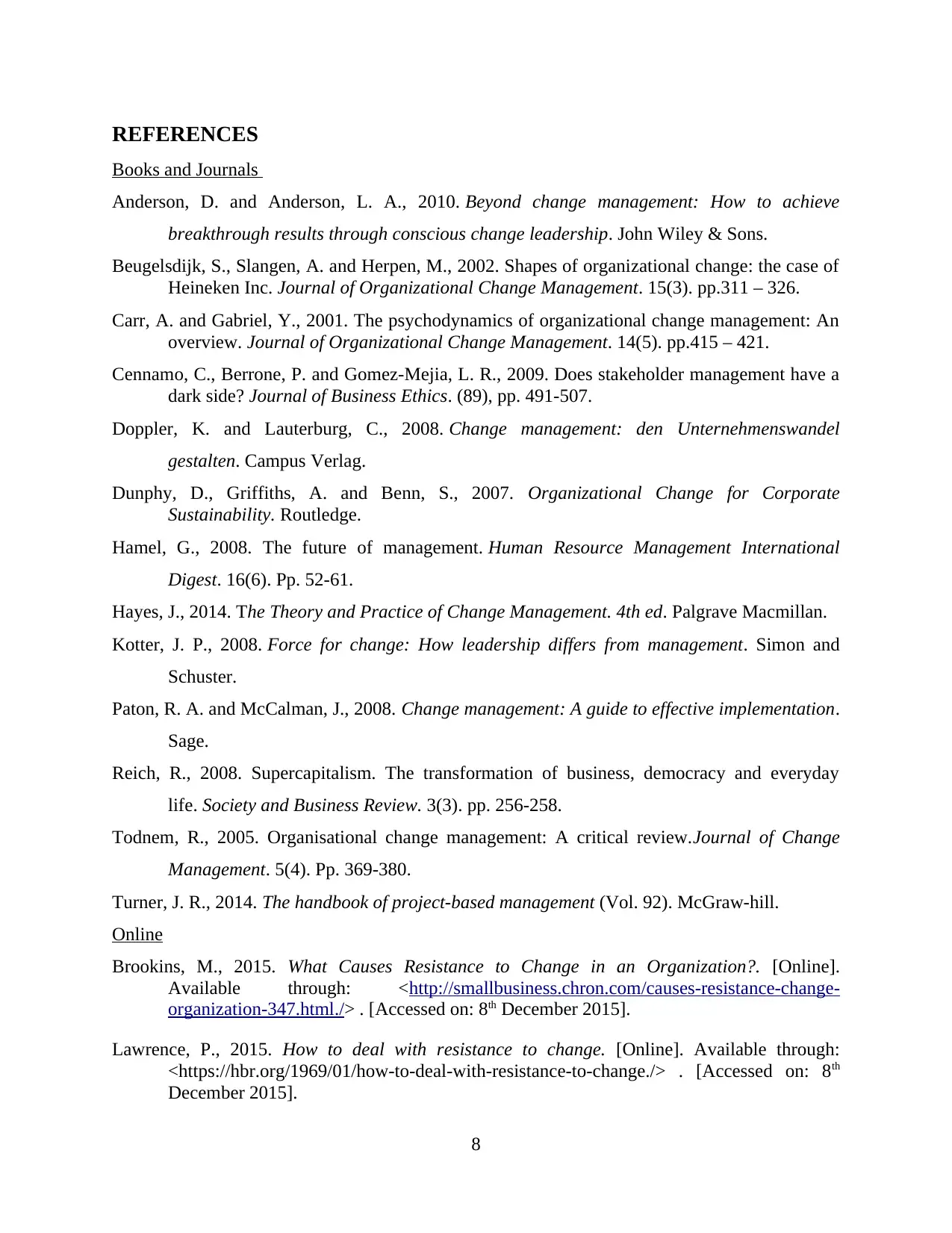
REFERENCES
Books and Journals
Anderson, D. and Anderson, L. A., 2010. Beyond change management: How to achieve
breakthrough results through conscious change leadership. John Wiley & Sons.
Beugelsdijk, S., Slangen, A. and Herpen, M., 2002. Shapes of organizational change: the case of
Heineken Inc. Journal of Organizational Change Management. 15(3). pp.311 – 326.
Carr, A. and Gabriel, Y., 2001. The psychodynamics of organizational change management: An
overview. Journal of Organizational Change Management. 14(5). pp.415 – 421.
Cennamo, C., Berrone, P. and Gomez-Mejia, L. R., 2009. Does stakeholder management have a
dark side? Journal of Business Ethics. (89), pp. 491-507.
Doppler, K. and Lauterburg, C., 2008. Change management: den Unternehmenswandel
gestalten. Campus Verlag.
Dunphy, D., Griffiths, A. and Benn, S., 2007. Organizational Change for Corporate
Sustainability. Routledge.
Hamel, G., 2008. The future of management. Human Resource Management International
Digest. 16(6). Pp. 52-61.
Hayes, J., 2014. The Theory and Practice of Change Management. 4th ed. Palgrave Macmillan.
Kotter, J. P., 2008. Force for change: How leadership differs from management. Simon and
Schuster.
Paton, R. A. and McCalman, J., 2008. Change management: A guide to effective implementation.
Sage.
Reich, R., 2008. Supercapitalism. The transformation of business, democracy and everyday
life. Society and Business Review. 3(3). pp. 256-258.
Todnem, R., 2005. Organisational change management: A critical review.Journal of Change
Management. 5(4). Pp. 369-380.
Turner, J. R., 2014. The handbook of project-based management (Vol. 92). McGraw-hill.
Online
Brookins, M., 2015. What Causes Resistance to Change in an Organization?. [Online].
Available through: <http://smallbusiness.chron.com/causes-resistance-change-
organization-347.html./> . [Accessed on: 8th December 2015].
Lawrence, P., 2015. How to deal with resistance to change. [Online]. Available through:
<https://hbr.org/1969/01/how-to-deal-with-resistance-to-change./> . [Accessed on: 8th
December 2015].
8
Books and Journals
Anderson, D. and Anderson, L. A., 2010. Beyond change management: How to achieve
breakthrough results through conscious change leadership. John Wiley & Sons.
Beugelsdijk, S., Slangen, A. and Herpen, M., 2002. Shapes of organizational change: the case of
Heineken Inc. Journal of Organizational Change Management. 15(3). pp.311 – 326.
Carr, A. and Gabriel, Y., 2001. The psychodynamics of organizational change management: An
overview. Journal of Organizational Change Management. 14(5). pp.415 – 421.
Cennamo, C., Berrone, P. and Gomez-Mejia, L. R., 2009. Does stakeholder management have a
dark side? Journal of Business Ethics. (89), pp. 491-507.
Doppler, K. and Lauterburg, C., 2008. Change management: den Unternehmenswandel
gestalten. Campus Verlag.
Dunphy, D., Griffiths, A. and Benn, S., 2007. Organizational Change for Corporate
Sustainability. Routledge.
Hamel, G., 2008. The future of management. Human Resource Management International
Digest. 16(6). Pp. 52-61.
Hayes, J., 2014. The Theory and Practice of Change Management. 4th ed. Palgrave Macmillan.
Kotter, J. P., 2008. Force for change: How leadership differs from management. Simon and
Schuster.
Paton, R. A. and McCalman, J., 2008. Change management: A guide to effective implementation.
Sage.
Reich, R., 2008. Supercapitalism. The transformation of business, democracy and everyday
life. Society and Business Review. 3(3). pp. 256-258.
Todnem, R., 2005. Organisational change management: A critical review.Journal of Change
Management. 5(4). Pp. 369-380.
Turner, J. R., 2014. The handbook of project-based management (Vol. 92). McGraw-hill.
Online
Brookins, M., 2015. What Causes Resistance to Change in an Organization?. [Online].
Available through: <http://smallbusiness.chron.com/causes-resistance-change-
organization-347.html./> . [Accessed on: 8th December 2015].
Lawrence, P., 2015. How to deal with resistance to change. [Online]. Available through:
<https://hbr.org/1969/01/how-to-deal-with-resistance-to-change./> . [Accessed on: 8th
December 2015].
8
Secure Best Marks with AI Grader
Need help grading? Try our AI Grader for instant feedback on your assignments.

9
1 out of 11
Your All-in-One AI-Powered Toolkit for Academic Success.
+13062052269
info@desklib.com
Available 24*7 on WhatsApp / Email
![[object Object]](/_next/static/media/star-bottom.7253800d.svg)
Unlock your academic potential
© 2024 | Zucol Services PVT LTD | All rights reserved.



